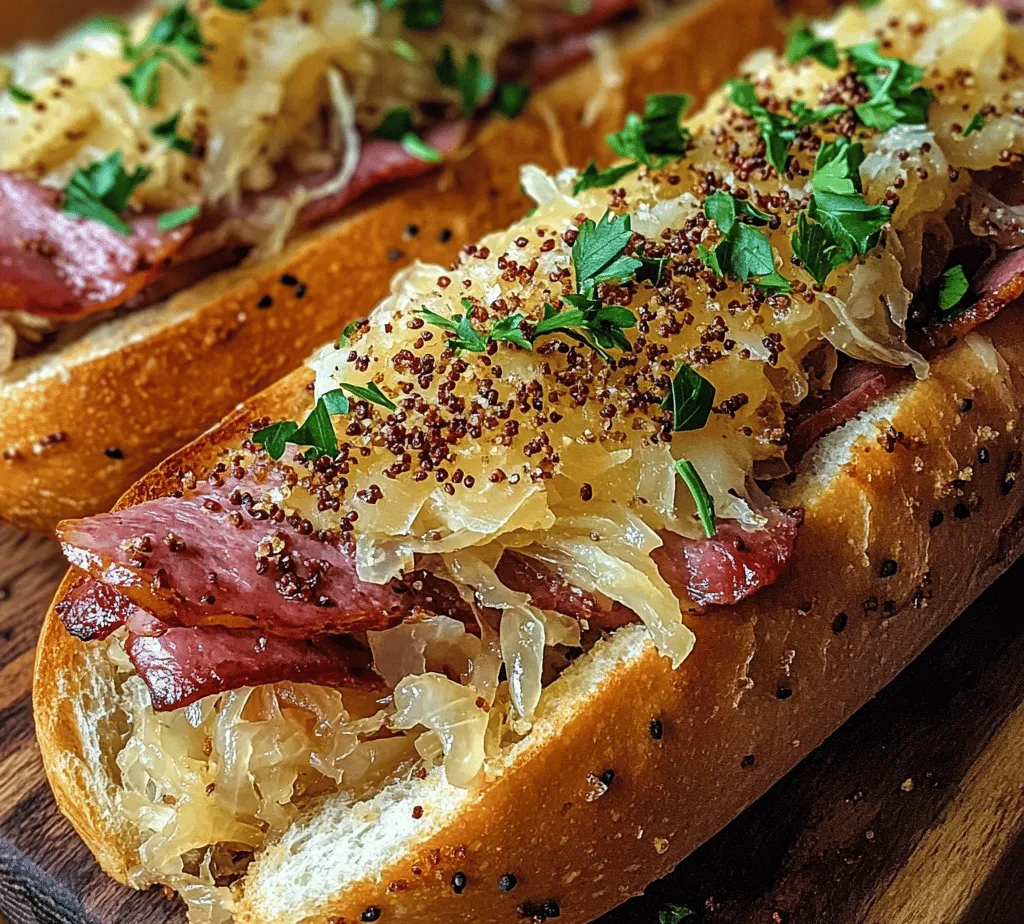Introduction
Pastrami and sauerkraut are two culinary staples that have made their mark in the world of deli cuisine, particularly within Jewish and Eastern European cultures. Originating from the heart of New York City’s bustling delis, pastrami is a beloved cured meat that boasts a rich history and a unique flavor profile. It is typically made from beef brisket, which is cured in a blend of spices, smoked, and steamed to perfection. Sauerkraut, on the other hand, is a traditional fermented cabbage dish that offers a tangy, crisp contrast to the savory depth of pastrami.
The combination of pastrami and sauerkraut is a match made in heaven, balancing the umami flavors of the meat with the sour crunch of the cabbage. This pairing has inspired many culinary creations, one of the most delightful being the Pastrami & Sauerkraut Rolls. This recipe presents a hearty dish that encapsulates the essence of deli flavors while offering a modern twist by using hoagie or pretzel rolls as the base. The result is a satisfying meal that is not only enjoyable to eat but also easy to prepare, making it perfect for busy weeknights or casual gatherings.
In this article, we will delve into the cultural significance of pastrami and sauerkraut, explore the ingredients that create this delectable dish, and provide you with detailed preparation steps to ensure your rolls are a hit at the dinner table. Whether you are a seasoned chef or a novice in the kitchen, these Pastrami & Sauerkraut Rolls are sure to impress.
Understanding the Ingredients
To create the perfect Pastrami & Sauerkraut Rolls, it’s essential to understand the key ingredients that bring this dish to life. Each component plays a vital role in crafting a flavorful and satisfying meal.
Pastrami
Pastrami has a storied history that traces back to the Jewish communities of Romania. Originally, the meat was a method of preservation, allowing families to store protein for an extended period. Today, pastrami is celebrated for its intense flavor and tender texture, which is achieved through a meticulous process of curing, seasoning, smoking, and steaming.
When it comes to flavor, pastrami stands out with its smoky, peppery notes, often accentuated by a generous layer of spices including black pepper, coriander, and garlic. This robust profile makes pastrami a beloved choice for sandwiches and rolls, as its richness pairs beautifully with various condiments and accompaniments.
Sauerkraut
Sauerkraut, meaning “sour cabbage” in German, is another ingredient with deep cultural roots. This fermented dish originated in China and made its way to Europe, where it became a staple in many households. The preparation of sauerkraut involves finely shredding cabbage and fermenting it with salt, which allows beneficial bacteria to thrive. This fermentation not only preserves the cabbage but also enhances its nutritional profile, making sauerkraut a source of probiotics, vitamins C and K, and dietary fiber.
The tangy flavor of sauerkraut provides a perfect counterbalance to the richness of pastrami, adding a burst of acidity that cuts through the meat’s fat. Additionally, the crunchiness of sauerkraut adds texture to the rolls, making each bite a delightful experience.
Hoagie and Pretzel Rolls
When it comes to the foundation of our Pastrami & Sauerkraut Rolls, we have two excellent options: hoagie rolls and pretzel rolls.
– Hoagie Rolls: These long, soft bread rolls are commonly used for sandwiches and are known for their chewy texture and slight crust. They provide a neutral base that allows the flavors of pastrami and sauerkraut to shine. Their shape is perfect for holding generous portions of filling, making them a classic choice for deli-style rolls.
– Pretzel Rolls: For a unique twist, pretzel rolls add a distinct flavor and texture to the dish. Coated with a lye solution that gives them their signature dark brown crust, pretzel rolls are chewy on the outside and soft on the inside. The slightly salty and malty flavor of pretzel rolls complements the savory pastrami and tangy sauerkraut, creating a delightful combination.
Both options work beautifully in this recipe, so feel free to choose based on your preference or availability.
Swiss Cheese
No pastrami roll would be complete without Swiss cheese. This semi-soft cheese is known for its mild, nutty flavor and excellent melting properties, making it a perfect companion for hot sandwiches. When melted, Swiss cheese adds creaminess to the rolls, enhancing the overall mouthfeel and flavor profile. The cheese also acts as a binding agent, helping to hold the filling together while adding a rich, comforting layer.
Dijon Mustard and Mayonnaise Spread
To elevate the flavor of the Pastrami & Sauerkraut Rolls, we incorporate a spread made from Dijon mustard and mayonnaise. The sharpness of Dijon mustard brings a zesty kick that complements the savory pastrami, while the creamy texture of mayonnaise adds moisture and richness. This combination creates a balanced spread that enhances every bite without overpowering the other flavors.
Caraway Seeds
Caraway seeds are an optional but traditional ingredient that can be added to the sauerkraut for an extra layer of flavor. Known for their distinctive anise-like taste, caraway seeds are commonly used in dishes featuring cabbage, enhancing the overall flavor profile. If you enjoy the combination of flavors, consider adding a teaspoon of caraway seeds to your sauerkraut for a classic touch.
Preparation Steps Explained
Now that we’ve explored the ingredients that make up our Pastrami & Sauerkraut Rolls, let’s break down the preparation steps to ensure your rolls come out perfectly every time.
Step 1: Gather Your Ingredients
Before you begin, make sure you have all the necessary ingredients at hand:
– 1 pound of sliced pastrami
– 1 cup of sauerkraut, drained and rinsed
– 4 hoagie rolls or pretzel rolls
– 4 slices of Swiss cheese
– 2 tablespoons of Dijon mustard
– 2 tablespoons of mayonnaise
– Optional: 1 teaspoon of caraway seeds (if using sauerkraut)
Step 2: Prepare the Spread
In a small bowl, combine the Dijon mustard and mayonnaise. Mix until well blended. This spread will add a creamy texture and a zesty flavor to your rolls.
Step 3: Heat the Pastrami and Sauerkraut
In a skillet over medium heat, add the sliced pastrami and sauté for about 2-3 minutes until warmed through. If you’re using caraway seeds, add them to the sauerkraut and sauté together with the pastrami during this time to infuse the flavors. You want the pastrami to be hot and slightly crispy around the edges, enhancing its flavor.
Step 4: Toast the Rolls
While the pastrami is heating, slice your hoagie or pretzel rolls lengthwise, making sure not to cut all the way through. You want to create a pocket for the filling. If you’re using pretzel rolls, consider giving them a quick toast in the oven for about 3–5 minutes until they are warm and slightly crispy. This will add an extra layer of texture to your rolls.
Step 5: Assemble the Rolls
Once the pastrami and sauerkraut are heated and your rolls are toasted, it’s time to assemble your Pastrami & Sauerkraut Rolls. Start by spreading the Dijon-mayonnaise mixture generously inside each roll. Then, layer in the warm pastrami followed by a scoop of sauerkraut. Top each roll with a slice of Swiss cheese, allowing it to melt slightly from the warmth of the filling.
Step 6: Final Heating
For an added touch, you can return the assembled rolls to the skillet or place them in a preheated oven at 350°F (175°C) for about 5 minutes. This will melt the cheese beautifully and help bind the flavors together. If you prefer a crispy top, consider placing them under the broiler for an additional minute or two—just keep a close eye on them to prevent burning.
This step-by-step process will ensure that your Pastrami & Sauerkraut Rolls are not only delicious but also visually appealing, with melted cheese oozing from the sides and a delightful crunch from the toasted rolls.
With these preparation steps and a thorough understanding of the ingredients, you’re well on your way to creating a dish that celebrates the rich flavors and cultural significance of pastrami and sauerkraut in a fun and modern way. Stay tuned for more tips and variations to elevate your Pastrami & Sauerkraut Rolls experience!

Preheating the Oven
Preheating the oven is a crucial step in the baking process, particularly for Pastrami & Sauerkraut Rolls. This step ensures that the rolls bake evenly from the moment they are placed inside. By starting with a hot oven, you create a consistent cooking environment that promotes proper rising and browning of the dough. Ideally, preheat your oven to 375°F (190°C) at least 15 minutes before you’re ready to bake. This allows the heating elements to reach the desired temperature, resulting in a perfectly baked roll with a golden crust and a fluffy interior.
Preparing the Rolls
When it comes to preparing your rolls, proper slicing is key to ensuring the filling stays intact. Begin by taking your favorite sandwich rolls—soft white rolls or hearty whole grain work well. Use a serrated knife for a clean cut and slice the rolls horizontally, leaving one side attached to create a pocket for the filling. To prevent tearing, gently press down on the roll while slicing and take your time to ensure an even cut.
After slicing, carefully hollow out some of the bread from the inside of the rolls if you prefer a less bready finish. This step also helps in accommodating the filling without making the rolls too bulky. Make sure to leave enough bread on the sides and bottom to hold everything together securely.
Mixing the Spread
The spread is a vital component of Pastrami & Sauerkraut Rolls, contributing a flavorful kick that enhances the overall taste. To achieve the perfect balance of flavors, you can combine ingredients like Dijon mustard, mayonnaise, and a touch of horseradish for heat. Start with equal parts of mayonnaise and mustard, then add a teaspoon of horseradish and mix until well-blended. Taste as you go, adjusting the ingredients to your preference—more mustard for tanginess, more mayo for creaminess, or more horseradish for an extra bite. This spread not only adds flavor but also acts as a moisture barrier, keeping the rolls from becoming soggy.
Layering Ingredients
The order in which you layer your ingredients can significantly affect both the texture and flavor of your Pastrami & Sauerkraut Rolls. Start with a generous spread of your prepared mixture on the inside of the rolls, ensuring even coverage. Next, add a layer of pastrami—thinly sliced for optimal flavor distribution—making sure to fill the roll completely.
Following the pastrami, add a layer of sauerkraut. The tanginess of the sauerkraut complements the richness of the pastrami beautifully. You may also want to incorporate a layer of cheese—Swiss or provolone are excellent choices—before topping it with another spread of your mixture. This layering technique not only enhances the flavor but also ensures that each bite is a delightful combination of all the components.
Brushing with Olive Oil
Brushing the tops of your filled rolls with olive oil before baking is an essential step for achieving a beautifully golden crust. Olive oil adds flavor and promotes browning, which enhances both the visual appeal and the texture of the rolls. Use a pastry brush to apply a thin layer of olive oil to the tops of each roll, making sure to cover them evenly. This small step can make a big difference in the final presentation of your rolls, giving them a shiny, appetizing surface that is hard to resist.
Baking Tips
Monitoring the baking process is essential to avoid overcooking your Pastrami & Sauerkraut Rolls. After placing the rolls in the preheated oven, set a timer for 15 minutes. Keep an eye on the rolls, looking for a golden-brown color and a lightly crisp texture. If your rolls are browning too quickly, you can tent them with aluminum foil to prevent burning while allowing them to cook through.
After 15 minutes, check the internal temperature of the rolls. They should be heated through, and the cheese should be melted. If necessary, continue baking for an additional 5-10 minutes, checking frequently to ensure they do not overbake. Once they are ready, remove them from the oven and let them cool for a few minutes before serving. This cooling time allows the flavors to settle.
Nutritional Information
Pastrami & Sauerkraut Rolls are not only delicious but also provide a balanced nutritional profile. Each roll typically contains around 300-400 calories, depending on the size and ingredients used. The protein content from the pastrami is significant, offering approximately 15-20 grams per serving. Sauerkraut contributes dietary fiber and probiotics, which are beneficial for digestive health. The presence of healthy fats from the olive oil and cheese aids in nutrient absorption.
When considering carbohydrates, the rolls themselves provide around 30-40 grams. This balance of protein, carbohydrates, and healthy fats makes Pastrami & Sauerkraut Rolls a satisfying meal option, providing sustained energy without excessive calories. Incorporating sauerkraut not only improves flavor but also adds the health benefits associated with fermented foods, such as enhanced gut health and improved digestion.
Serving Suggestions
Pastrami & Sauerkraut Rolls are incredibly versatile and can be served in various ways. For a classic pairing, consider serving them alongside potato salad, which adds a creamy texture that complements the savory flavors of the rolls. Chips can provide a satisfying crunch, and pickles offer a tangy contrast that enhances the overall meal.
For a lighter option, a simple side salad with fresh greens, tomatoes, and a vinaigrette dressing can add brightness to your plate. If you want to elevate your rolls further, consider adding variations. Experiment with different cheeses—like sharp cheddar or pepper jack—for a unique flavor twist. You can also add toppings such as jalapeños for heat or fresh herbs like dill for a refreshing touch.
Cultural Context and Variations
Pastrami and sauerkraut are ingredients deeply rooted in various culinary traditions, particularly within Jewish and German cuisines. Pastrami, originally from Romanian Jewish immigrants, has become a staple in delis across the United States, often served on rye bread. Sauerkraut, a fermented cabbage dish, has historical significance in German cuisine, celebrated for its preservation methods and health benefits.
Variations of Pastrami & Sauerkraut Rolls can include using different meats, such as corned beef or turkey pastrami, for a lighter option. You can also experiment with additional vegetables like roasted peppers or even spicy mustard greens to add complexity to the flavor profile. The beauty of this dish lies in its adaptability, allowing home cooks to explore different tastes and textures.
Conclusion
Pastrami & Sauerkraut Rolls are a comforting and flavorful dish that resonates with many culinary traditions. Their balanced blend of savory pastrami, tangy sauerkraut, and rich cheese creates a satisfying meal that is perfect for casual gatherings or hearty family dinners. The ability to customize these rolls encourages creativity in the kitchen, inviting you to explore personal touches that reflect your taste preferences.
Whether you serve them at a picnic, a game day gathering, or simply enjoy them at home, these rolls are sure to impress your family and friends. The joy of creating and sharing Pastrami & Sauerkraut Rolls is unparalleled, making them an ideal choice for anyone looking to delve into the world of delicious, hearty sandwiches. Don’t hesitate to try this recipe and make it your own, embracing the delightful flavors and the rich cultural context behind this beloved dish.



